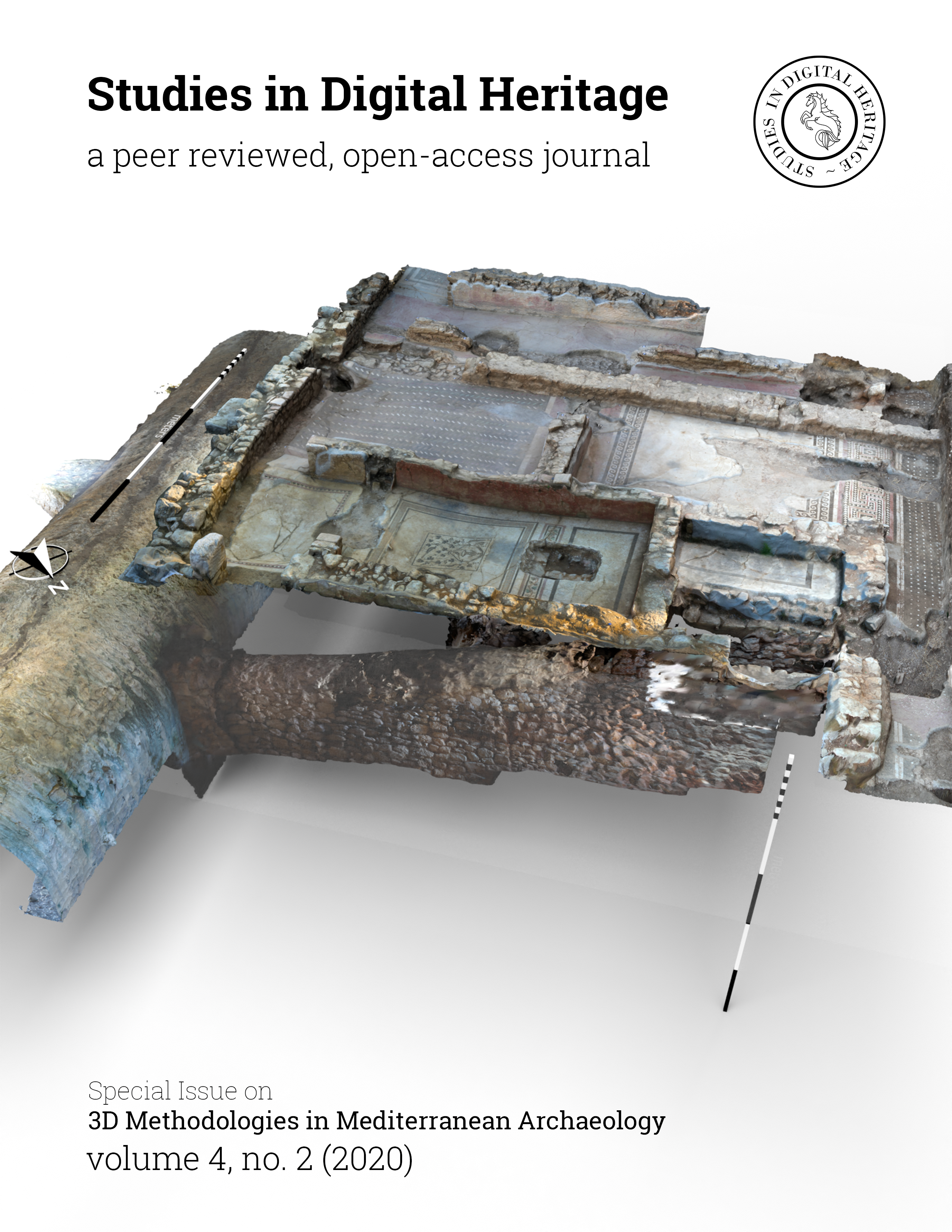Putting Space Syntax to the Test Digital Embodiment and Phenomenology in the Roman House
Main Article Content
Abstract
While space syntax analysis has been widely applied to archaeological sites (including Pompeii), it is fundamentally limited by its isolation within the social sciences and its omission of decoration from the analysis of human cognition and movement within structures. At the same time, phenomenology in archaeology has typically arisen from the physical experiences of a limited number of professional archaeologists in a landscape, with little interest in digital embodiment in virtual spaces. The Virtual Pompeii Project has produced an updated version of space syntax which combines network measures common in the social sciences with visibility graphs to produce predictive models of movement within a set of three ancient Roman houses in Pompeii. These predictive models are tested through the navigation of virtual models of the houses by human subjects, demonstrating the significance of decoration in shaping movement, and, through quantitative and qualitative data, the value of digitally embodied phenomenology. This points ahead to the use of crowd-sourced, web-based global testing, diversifying the subject pool far beyond the narrow bounds of professional classicists or archaeologists.
Downloads
Article Details

This work is licensed under a Creative Commons Attribution-NonCommercial 4.0 International License.
From 18 May 2018, the contents of Studies in Digital Heritage are licensed under a Creative Commons Attribution-NonCommercial 4.0 International License (CC BY-NC 4.0). Our submitting authors pay no fee and retain the copyright to their own work.
How this works: to submit their work to the journal, authors grant Studies in Digital Heritage a nonexclusive license to distribute the work according to a CC BY-NC 4.0 license. Once an article is published, anyone is free to share and adapt its contents—provided only that they do so for noncommercial purposes and properly attribute the shared or adapted information. Details of these terms can be found on the Creative Commons website.
Download SDH’s full author agreement here
Studies in Digital Heritage will insert the following note at the end of any work published in the journal:
© [Year] by the authors. This article is an open-access article distributed under the terms and conditions of the Creative Commons Attribution License CC BY-NC 4.0 (https://creativecommons.org/licenses/by-nc/4.0/).
References
Anderson, Michael. 2004. Mapping the domestic landscape: GIS, visibility and the Pompeian house. In F. Niccolucci and S. Hermon, eds. Beyond the artefact Digital Interpretation of the Past - Proceedings of CAA 2004 - Prato 13-17 April 2004, Budapest: Archeolingua: 183-189.
Anderson, Michael. 2005. Houses, GIS and the micro-topology of Pompeian domestic space. In J. Bruhn, Ben Croxford, Dimitris Grigoropoulos, eds. TRAC 2004: proceedings of the 14th annual Theoretical Roman Archaeology Conference, Oxford: Oxbow Books: 1-9.
Brück, Joanna. 2005. Experiencing the past? The development of phenomenological archaeology in British prehistory. Archaeol. Dialogues 12.1: 47–72.
Dickmann, Jens-Arne. 1999. Domus Frequentata. Anspruchsvolles Wohnses im Pompejanischen Stadthaus, Munich: Verlag Dr. Friedrich Pfeil.
Farrow, Robert and Ioanna Iacovides. 2014. Gaming and the limits of digital embodiment. Philosophy & Technology 27.2: 221–233.
Fisher, Kevin D. 2009a. Placing social interaction: An integrative approach to analyzing past built environments. Journal of Anthropological Archaeology 28: 439–457.
Fisher, Kevin D. 2009b. Elite place-making and social interaction in the Late Cypriot Bronze Age. Journal of Mediterranean Archaeology 22.2:183–209.
Fleming, Andrew. 2006. Post-processual landscape archaeology: a critique. Cambridge Archaeological Journal 16.3: 267-280.
Fleming, Andrew. 2008. Debating landscape archaeology. Landscapes 9: 74-76.
Gee, James. 2008. Video games and embodiment, Games and Culture 3.3: 253-63.
Grahame, Mark. 2000. Reading space: social interaction and identity in the houses of Roman Pompeii. British Archaeological Reports, International Series 886, Oxford: Archaeopress.
Hamilton, Sue, Ruth Whitehouse, Keri Brown, Pamela Coombes, Edward Herring, and Mike Seager Thomas. 2006. Phenomenology in practice: towards a methodology for a ‘subjective’ approach. Eur. J. Archaeol 9:31–71.
Hillier, Bill and Julienne Hanson. 1984. The social logic of space, Cambridge: Cambridge University Press.
Johnson, Matthew. 2007. Ideas of Landscape, Oxford: Blackwell.
Johnson, Matthew. 2012. Landscape Studies: The Future of the field. In S. J. Kluiving and E. B. Guttmann-Bond, eds. Landscape Archaeology between Art and Science: From a Multi- to an Interdisciplinary Approach. Amsterdam: Amsterdam University Press: 515-526.
Kaiser, Alan. 2011. Roman Urban Street Networks, New York, London: Routledge.
Keogh, Brendan. 2018. A play of bodies: How we perceive video games, Cambridge, MA: MIT Press.
Ostwald, Michael. 2011. The mathematics of spatial configuration: Revisiting, revising and critiquing Justified Plan Graph Theory. Nexus Network Journal 13: 445–470.
Robb. Matthew. 2007. The spatial logic of Zacuala, Teotihuacan. In Proceedings, 6th International Space Syntax Symposium, İstanbul, 2007:1-16.
Roullet, Cindy David Fredrick, John Gauch, Rhodora G. Vennarucci. 2019. Automated Technique to Recognize and Extract Images from Scanned Archaeological Documents. In 2019 International Conference on Document Analysis and Recognition Workshops (ICDARW), Sydney, 2019: 20-25.
Spence-Morrow, GIles. 2009. Analyzing the invisible: syntactic interpretation of archaeological remains
through geophysical prospection. In Proceedings of the 7th International Space Syntax Symposium, Stockholm, 2009: 1-10.
Stöger, Hanna. 2015. Roman neighbourhoods by the numbers: A space syntax view on ancient city quarters and their social life. The Journal of Space Syntax 6.1: 61-80.
Tilley, Chris. 1994. A phenomenology of landscape: Places, paths, and monuments, Oxford: Berg Publishers.
Van Dyke, Ruth. 1999. Space syntax analysis at the Chacoan outlier of Guadalupe. American Antiquity 64.3: 461-473.
van Nes, Akkelies. Indicating street vitality in excavated towns. Spatial configurative analyses applied to Pompeii. In Eleftheria Paliou, Undine
Lieberwirth, and Silvia Polla, eds. Spatial analysis and social spaces. Berlin: de Gruyter: 277-96.
von Stackelberg, Katherina. 2009. The Roman garden: space, sense, and society, London: Routledge.
Weilguni, Marina. 2011. Streets, spaces and places: Three Pompeiian movement axes analysed, Boreas: Uppsala Studies in Ancient Mediterranean and Near Eastern Civilizations 33.


